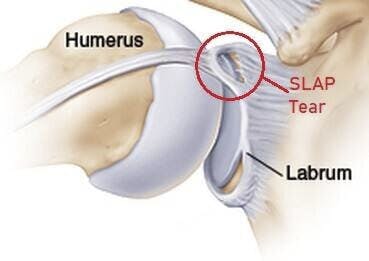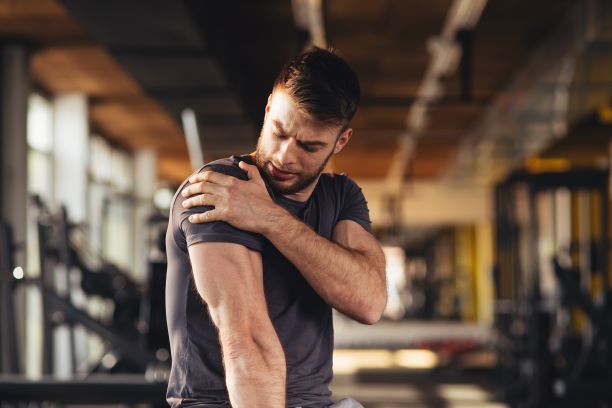Pain with or without clicking deep in your shoulder may be from a labrum injury. The glenoid labrum is a cartilage layer within your shoulder joint’s socket. It plays an important role in stabilizing your shoulder during pushing movements, overhead reaching, and sports that involve throwing.
Repetitive overhead throwing in baseball players often leads to the breakdown of your labrum. Repetitive pressing or pushing movements in the gym also irritate your labrum. Trauma like falling on an outstretched arm or bracing yourself during a car accident can injure your labrum.
Surgery is often recommended to repair a torn labrum. However, exercise is also a very effective treatment option. Non-operative management includes non-steroidal anti-inflammatory drugs and steroid injections to decrease pain and inflammation. Physical therapy and exercise also play an important role in recovering the full function of your shoulder. This article outlines a game plan for rehabbing your injured shoulder after a labrum injury.

Surgery or No Surgery for Glenoid Labrum Tears?
Both surgery and a non-surgical approach can yield satisfactory results in 66% to 85% of people with labrum tears. A small study published in The American Journal of Sports Medicine suggests nearly 1/2 of those with labrum tears do well with surgery. The same is true for those who pursue non-surgical treatment.
Regardless of treatment, 80% to 85% report satisfactory results 2 to 3 years later. However, satisfaction and return to sport in overhead athletes is closer to 66%. This is understandable given the demands baseball pitchers and tennis players place on their shoulders.
Patients with labrum injuries should undergo 3 to 6 months of non-surgical treatment before considering surgery. If this approach fails your doctor may recommend surgery. Rehab focuses on improving shoulder range of motion and strengthening your rotator cuff and shoulder blade muscles. Below are 2 important stretches and 3 commonly prescribed strengthening exercises to perform after a labrum injury.
Cross-Body Stretch
This stretch addresses tightness in the back of your shoulder. This area is often stiff in overhead athletes. The infraspinatus, teres major, and teres minor muscles become shortened from repetitive throwing or weight training.
Lay on your side with your hips and knees bent. Position your involved shoulder and elbow at 90 degrees of flexion. Your hand on the uninvolved arm grasps your elbow and gently pulls it across the body. You should feel a mild stretch on the outside or back of your shoulder. Hold this position for 30 seconds. Perform this stretch 2 to 3 times each session.
Sleeper Stretch
The cross-body stretch is superior to the sleeper stretch for improving shoulder range of motion in young baseball players. However, the sleeper stretch is the more popular of the 2 stretches.
Start in the same position as the cross-body stretch. However, with the sleeper stretch, gently move your wrist and forearm down toward the table. You will feel a mild stretch on the outside or back of your shoulder. Hold this position for 30 seconds. Perform 2 to 3 stretches each session.
For most people, both the sleeper and cross-body stretch do not need to be performed. Our professional experience, and the best available evidence, suggest the cross-body stretch is the most beneficial for improving range of motion. Choose which one works best for you.
Shoulder Flexion in Side-lying
It is important to strengthen your shoulder muscles while limiting stress on your injured labrum. The biceps tendon attaches to your labrum. Strong contractions of your biceps muscle pull on the upper part of your labrum. Therefore it is best to perform strengthening exercises that minimize biceps activity.
Perform shoulder flexion raises in a side-lying position to minimize biceps activity and reduce strain on your labrum. Start on your side holding a light dumbbell. Keep your elbow straight as you raise your arm slightly overhead. Keep your arm parallel to the floor as you perform the movement. Perform 3 sets of 10 to 20 repetitions several times per week.
External Rotation Diagonal
Stand holding a resistance band in one hand. Anchor the band at your knee to waist level. Start with your hand positioned in front of your opposite front hip pocket. Maintain your elbow bent at a right angle throughout the exercise.
Perform the movement by flexing and rotating your arm across your body. You will end up in a position similar to the arm cocking part of throwing. Hold this position for 1 to 2 seconds. Reverse the movement back to the starting position. This is a great exercise for your rotator cuff and lower trapezius muscle. Perform 3 sets of 12 to 20 repetitions several times per week.
Prone Row to External Rotation
Lie on your stomach with your arm hanging over the side of your bed or a treatment table (if available). Hold a light dumbbell. Usually, 1 or 2 pounds is enough to begin.
Perform a high row with your elbow in line with your shoulder. Pause for 1 to 2 seconds then rotate your hand upward towards the ceiling. Hold this position for 1 to 2 seconds. Reverse the movement back to the starting position.
This is another great exercise for your rotator cuff and lower trapezius muscle. Perform 3 sets of 8 to 12 repetitions several times per week.
See Your Physical Therapist to Get Started
Symptoms of a labrum injury can range from minor annoyance to debilitating. In many people, it severely limits overhead activity and the ability to carry out routine daily activities. The right exercises will help. For the best results, exercise 3 to 5 times per week. Infrequent or random exercise will do you little good. Give these 5 exercises a shot for at least 3 months and see how things go for you.
If you want more help give us a call. Our physical therapists will help you find additional exercises that are right for you and also supplement these with manual therapy treatments. You don’t have to keep suffering and you have options other than surgery.


